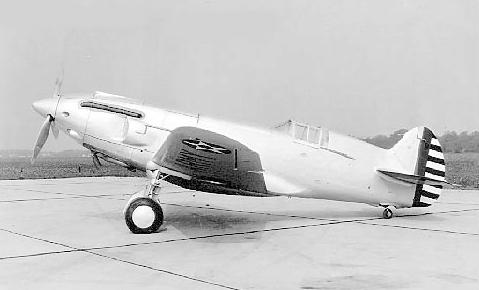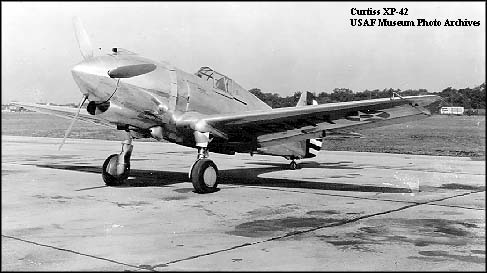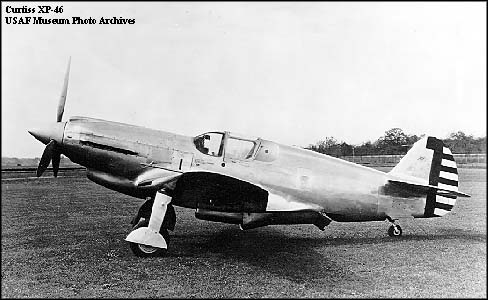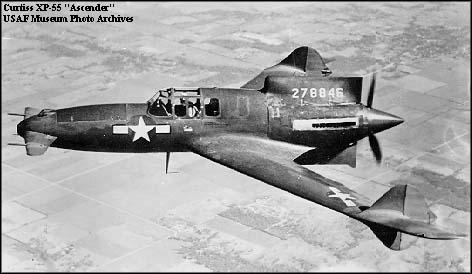
Join Amazon Prime - Watch Thousands of Movies & TV Shows Anytime - Start Free Trial Now
Curtiss Wright Failures


The XP-37, little remembered by anyone now, was the evolutionary link between the Curtiss P-36/Hawk 75
and the last of the Curtiss Hawk series, the P-40 Warhawk. In 1937, Curtiss installed
a turbo-charged Allison
V1710-11 engine into the model 75 prototype airframe. Designated the model 75I, the aircraft was tested by
the USAAC as the XP-37. The test program was troubled with many engine and turbo-charger problems. Nonetheless, the
aircraft was the first fighter tested by the Army that could easily exceed 300 mph (483km/h) in level flight, and do it at an
altitude in excess of 21,000 feet.
The placement of the cockpit, very far to the rear of the fuselage, caused much consternation to the test pilots, who found forward vision impossible on the ground and poor in the air as well. The Army, however, saw enough promise in the basic design to order another 13 fighters with lengthened fuselage and a new, improved B2 turbo-charger. The cockpit was be to moved forward to a more conventional position. The resulting aircraft, although being improved, still suffered from problems with the powerplant installation.
During the process of testing the YP-37 fighters, Curtiss took the tenth P-36A from the production line and, removing the R-1830 radial engine, installed an Allison V-1710-19. This engine did not have a turbo-charger, but the normal mechanical supercharger.
This aircraft, designated the model 75P, did not look very much different from the YP-37. Flown in the 1939 Pursuit competition, the fighter, now designated by the AAC as the XP-40, was selected for production and an order for 524 aircraft was then placed with Curtiss.
All testing was soon ceased on the YP-37's and they were assigned to aviation obscurity. A failure in one sense, the XP-37 provided Curtiss with a baseline of data that directly led to the model 81 and later, model 87 fighters, which gave good service in WWII.
SPECIFICATIONS (XP-37)
Span: 37 ft. 4 in.
Length: 31 ft. 0 in.
Height: 9 ft. 6 in.
Weight: 5,272 lbs. empty/6,350 lbs. gross
Armament: One .30-cal. and one .50-cal. machine gun
Engine: Turbo-supercharged Allison V-1710-11 of 1,000 hp. at 20,000 ft.
PERFORMANCE
Maximum speed: 340 mph. at 20,000 ft.
Cruising speed: 304 mph.
Range: 485 miles
Service Ceiling: 35,000 ft.

The XP-42 came about as a major modification of the fourth (4th)
production P-36A to come off the production line. It tested the use of a
streamlined engine cowling designed to reduce the drag of a radial
engine. The rather long tapering cowling had a cooling air scoop under
the engine and carburetor air inlets on top. An extension shaft was
required to connect the engine to the distant propeller. The propeller,
had a very large spinner to blend into the cowling line. The revised
cowling really did not reduce drag very much. Several variations of the
cowling were tried, but drag was not reduced. What did occur was severe
engine overheating.
Later in its test life, the XP-42 was fitted was a slab type of stabilizer (not unlike modern fighters) and gained useful data on the use and application of this technology.
SPECIFICATIONS
Span: 37 ft. 4 in.
Length: 30 ft. 3 in.
Height: 12 ft. 0 in.
Weight: 4,818 lbs. empty/5,920 lbs. gross
Armament: None
Engine: Pratt & Whitney R-1830-31 of 1,050 hp.
PERFORMANCE
Maximum speed: 315 mph.
Cruising speed: 286 mph.
Range: 730 miles (105 gal.)/1200 miles with aux. tanks.

The Allison powered XP-46 did not achieve the performance that was expected during the Army's evaluation. As a result, no orders were forthcoming from the USAAC.
Instead, Curtiss redesigned the P-40, installing a new Allison V-1710-39 which made it's rated power to 11,700 feet. This engine used a different type of reduction gear which shortened the nose of the fighter markedly. In addition, the cockpit greenhouse was completely revised. The resulting aircraft was designated the P-40D (model 87) and the Kittyhawk I in British service.
SPECIFICATIONS
Span: 34 ft. 4 in.
Length: 30 ft. 2 in.
Height: 13 ft. 0 in.
Weight: 5,625 lbs. empty/6,750 lbs. gross
Armament: Four .30-cal. and 2 .50-cal. machine guns (XP-46); none (XP-46A)
Engine: Allison V-1710-39 of 1,150 hp.
PERFORMANCE
Maximum speed: 355 mph. at 12,200 ft.
Range: 325 miles
Service ceiling: 29,500 ft.

In November of 1939, the US Army Air Corps issued a requirement
and specification for a single seat interceptor that was to be
powered by the Pratt & Whitney X-1800-A3G engine. Manufacturers
were also encouraged to submit designs that were advanced or utilized
new technology. The designs would be required to have excellent
outward visibility, heavy armament and very low drag. Curtiss then submitted their proposal (CW-24). The Army took one quick
look at the Curtiss concept and promptly lost any interest. It
was far too radical for Army minds, always overly conservative,
to bear.
Curtiss, not yet discouraged, then elected to build a full scale flying mock-up. Designated the CW-24B, the demonstrator logged 160 flights powered by a 275 hp Menasco engine. Stability left something to be desired, and several modifications were made in the course of testing. Ultimately, the Army regained interest and issued a contract for three prototypes designated the XP-55. These aircraft would be powered by an Allison V-1710 engine as the X-1800-A3G never materialized.
The XP-55 was a tailless design low wing monoplane. The wings were sharply swept back (about 30 degrees). The wing incorporated ailerons, trailing edge flaps and small vertical stabilizers near the wing tips. A canard elevator was mounted at the nose with the elevator being a conventional hinged type. The aircraft made it's first flight in July 1943. This aircraft was lost several months later during stall testing. A result of the crash, was that all future testing would stay away from stall speeds until the third prototype could be modified to overcome the stall instability. Once the solution was incorporated on the 2nd prototype, the two aircraft were turned over to the Army for further evaluation.
The Army test program showed that while the XP-55 was a pleasant aircraft in level flight, its slow speed handling was still not very good and it's overall performance was well below the standard of newer fighter designs. As a result, the design was abandoned in late 1944.
SPECIFICATIONS
Span: 40 ft. 7 in. (later 44 ft. 6 ft.)
Length: 29 ft. 7 in.
Height: 10 ft. 0 in.
Weight: 6,354 lbs. empty/7,710 lbs. gross
Armament: Four .50-cal. machine guns
Engine: Allison V-1710-95 of 1,275 hp driving a pusher propeller
PERFORMANCE
Maximum speed: 390 mph. at 19,300 ft.
Service ceiling: 34,600 ft.
Cruising speed: 296 mph.
Climb: 7.1 minutes to 20,000 feet.
Armament: Four .50 cal. machine guns in the nose.
